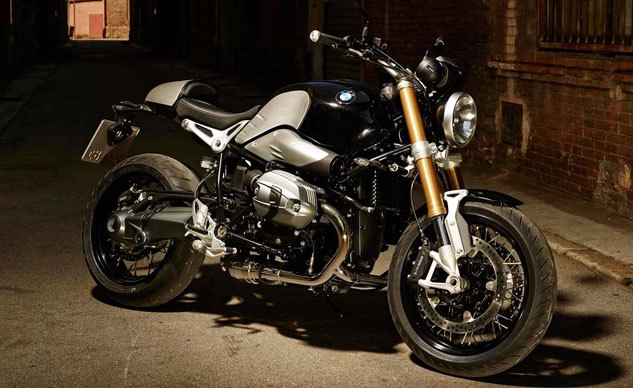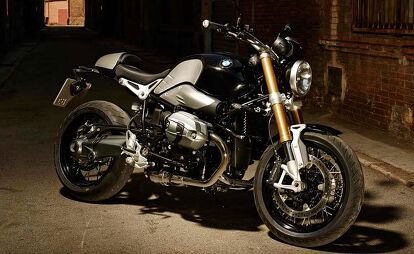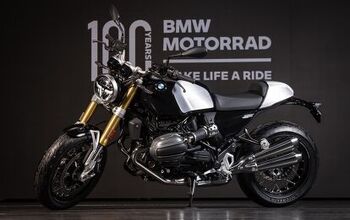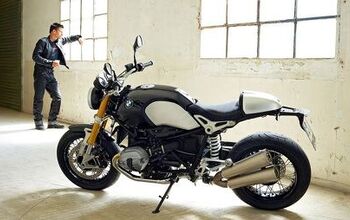2014 BMW R NineT Unveiling

BMW explores the beauty of minimalist elegance with a state-of-the-art classic
After 90 years, BMW wants to send a message. Yes, the company’s representatives and press releases said that the 2014 BMW R nineT is a present for the company, its customers and motorcyclists – which is to be expected. Doing anything for 90 years is admirable, and being, arguably, at the top of your game as you celebrate the anniversary is even better.
Visit BMW Nine-T Forum
Still, this is more than a company tooting its own horn. BMW is looking for something and wants to make a point about it. So the company flew us to Munich for our undivided attention.
The process of developing the nineT was frequently referred to as stripping down to the essentials or searching for simplicity or achieving authenticity or creating emotion. This gives a powerful clue of the designers’ intent. In fact, the word “puristic” kept popping up in the live translation the english-speaking press listened to during the entirely German language presentation. After the unveiling we even chuckled about how some terminology just doesn’t transfer between languages and postulated that puristic, which was said about a dozen times, most likely wasn’t even a real word. Well, once again, the native english speakers were wrong about their own language.
Click here for more pictures of the 2014 BMW Nine-T
Puristic is the adjective form of purist, which is defined as “strict observance of or insistence on purity in language, style, etc.” The designers (and, by extension, BMW as a company) are seeking to bring a BMW motorcycle in its most archetypical, elemental form to market.
Don’t mistake this for the design exercise seen so often in the V-Twin world where the bikes are intended to harken back to a lost (and possibly historically revised) ideal past, bikes where the nods to modernity are merely conveniences, like push button starting, or necessities to fulfill current requirements, as in fuel injection used to reduce emissions and improve mileage. Call the nineT a retro bike at this event, and the interviewees wearing a BMW logo bristle, stating that “this is no retro bike.” And they are right.
The nineT is intended to be a state-of-the-art modern motorcycle, only distilled down to its most elegantly minimalist form without all the laser-focused market segmentation that is the hallmark of current motorcycling. For lack of a better term, let’s call it a universal German motorcycle (UGM), which like the UJM of the era before specialization, is a blank slate for its owner to turn into the kind of motorcycle he or she wants to ride.
While the nineT is overtly directed towards those who have been asking BMW for a more customizable platform, the bike is also an attempt to update the definition of a motorcycle. Don’t believe us? How about BMW’s press kit: “With the nineT, BMW Motorrad is catering to the desire of many motorcycle enthusiasts to be creative with their bike and modify it to suit their individual taste and intended use.”
Now, before the more argumentative among you take issue the implication of a roadster being called a UGM, think of the advances in engine, braking and suspension technology and then consider the performance roots of BMW. A historically cognizant look at BMW’s past makes a strong case for the roadster being BMW’s standard. The style of the UJM was the way it was back in the day because that was the state of the art for a consumer motorcycle. Thankfully, time and technology have marched on to where we find ourselves today.
Rooted in History
When paring down to the elements of a pure BMW motorcycle, certain design traits must be maintained to stay true to the company’s DNA. First and foremost, the Boxer engine traces its genesis to BMW’s first motorcycle, the 1923 R 32. Look at any Boxer from the front and the lines are unmistakably BMW.
Since the new liquid-cooled Boxer in the R1200GS has a different front profile (and was designed for a more high performance usage), the decision was made to stick with the more traditional air/oil-cooled 101mm x 73mm 1170cc engine. The DOHC, four valve per cylinder engine is known for its hefty torque and distinctive sound. Delivering 110 hp at 7,750 rpm and 88 lb-ft peak torque at 6,000 rpm, the engine is well suited to provide exciting acceleration. The nineT’s shortened gearing serves to enhance the nineT’s quickness.
The shape of the gas tank is another distinctive BMW trait that has evolved over the years. The traditional wire-spoke wheels also add to the historical appeal of the nineT while the wheels’ design is a thoroughly modern cast aluminum hub and non-flanged rim. Although these are graced with classic black paint, the 17-inch rims wear modern sport-sized 120/70 ZR-17 front and 180/55 ZR-17 rear tubed rubber. Blending in with the natural color of the stainless steel spokes, the dual 320mm discs add modern technology to classic styled wheels. However, there’s nothing more state of the art than radial-mount, four-piston monoblock calipers and a S1000RR-sourced inverted fork. Fitting a Telelever front end, as is usually done on a Boxer, would have taken away from the classic lines that were desired.
The largely two-toned interplay between metal types, textures, and treatments throughout the nineT is one of the bike’s most arresting stylistic features. The in-your-face gold of the fork sits just inches away from forged aluminum brackets that have been glass-bead blasted and anodized a natural metallic color for an almost sand-cast yet shiny look.
Then there is the juxtaposition between the black metallic of the painted tank and where the scallops for the riders knees are simply a clear coat over the 4.8 gallon tank’s hand brushed aluminum. Glass-beaded, anodized brackets directly behind the seat visually tie the front and the rear of the bike. More brushed aluminum – with nineT embossed on the metal – wraps the intake duct on the right side of the bike.
While the exhaust headers are chrome, the dual stacked mufflers on the left side of the bike are blasted stainless steel. Under it all, the frame and engine block are anodized black, while the magnesium valve covers and the Paralever contrast slightly with a matt gray metallic color.
The two-toned theme carries over to the instrument cluster which has traditional, side-by-side, round analog speedometer and tachometer gauges while the center LCD panel is framed in grey. The readout features all the information we’ve come to expect from a modern onboard computer: time, engaged gear, remaining range, trip mileage, servicing interval, average speed and fuel consumption.
Designed for Modification
At the nineT’s unveiling, Director of Design at BMW Motorrad and lead designer on the nineT, Edgar Heinrich, said that there is a new generation of riders who want to fiddle with their motorcycles. This sentiment was echoed in BMW’s press materials: “The nineT pools together the genes from 90 years of BMW Motorrad and its unique concept has been designed to keep customization fans happy.”
When you consider the past, tinkering was a necessary part of just keeping a motorcycle running. Since the market wasn’t so segmented into narrowly focused classes of motorcycles, riders had to alter their machines to make it possible to do the kind of riding they wanted to do. As modern motorcycles have gotten progressively more reliable, the mechanic’s urge remains but needs a new area on which to focus. For many, this urge has switched to customization.
Ironically, BMW’s statements about the ideal customer for the nineT closely parallel those of Yamaha at the introduction of the Bolt earlier this year. Clearly both manufacturers are getting similar results to their customer research – only at opposite ends of the price spectrum.
However, when Stephan Schaller, Head of BMW Motorrad, was asked about this similarity in statements, he said that BMW did not have Yamaha in mind but rather Harley-Davidson, with its customer and aftermarket involvement in customization as the influence. This presents a sea change for BMW whose approach has usually been to provide only the accessories that were produced by the factory – ostensibly for “safety” reasons. In addition, BMW executives rarely, if ever, mention any other manufacturers by name, preferring to keep the focus on the superiority of the company’s designs.
In order to make the nineT a vehicle for customization, the bike was developed with a modular concept that would enable owners to more easily change the bike. The tubular steel frame features sporty geometry of 25.5 degree rake and 4.0 inches of trail on a 58.1 in. wheelbase yet was built with four distinct sections: the front main frame, rear main frame, frame end-piece, and a rear sub-frame. The front section with the steering head bolts directly to the engine and utilizes it as a stressed member. The rear section connects the swingarm pivot to the engine.
The sub-frame was designed to be easily removable with just eight fasteners, leaving the tail of the bike open for BMW accessories or aftermarket components. The bike comes with a dual seat standard, but pillion can be replaced with an accessory, brushed-aluminum tail cover for a cleaner appearance. For an even more radical, bobber-esque look, remove the entire sub-frame and have the seat floating off the tail of the bike, while the signals and license plate could be attached to the sub-frame mounts. A skilled builder could even fabricate an entirely new sub-frame to achieve whatever look was desired or to alter the 30.9 in. seat height to accommodate rider size.
Similarly, the nineT’s electrical system was created with customizers in mind. The wiring harness has the engine and other wiring separated to decrease the difficulty of major electrical modifications. While this is largely the province of professional builders, the factory also considered the ease of installing aftermarket electrical items like headlights and turn signals. Remember, this is from the same manufacturer that insisted for years that its use of three switches to operate turn signals was superior to the more common single switch approach – despite how riders felt about it.
The nineT has traveled a long way since it was first sneak peeked as the Lo Rider Concept in 2008. Earlier this year the Roland Sands Design Concept 90 reignited public interest in BMW’s reimagined roadster.
If the reaction of the people present at the nineT’s unveiling in Munich is any gauge, BMW will have a hit on its hands. Neither release date nor price have been set, but its price will surely come in as a premium to the R1200’s $13,880 MSRP. Has BMW created the Universal German Motorcycle? Go see a nineT when they’re available and find out for yourself.
2014 2014 BMW R nineT Specs
| MSRP | TBD |
| Engine | Air/oil-cooled, twin-cylinder Boxer |
| Displacement | 1170cc |
| Bore x stroke | 110 x 70 mm |
| Horsepower | 110 hp @ 7750rpm (claimed) |
| Torque | 88 ft-lb. @ 6000 rpm (claimed) |
| Compression ratio | 12.0:1 |
| Fuel System | EFI |
| Transmission | Six-speed |
| Clutch | Hydraulically activated dry clutch |
| Final drive | Cardan shaft |
| Frame type | Tubular steel bridge frame with engine as stressed member |
| Front suspension | Inverted 46mm telescopic fork |
| Rear suspension | BMW Paralever with central strut, shock adjustable for preload |
| Front brakes | Dual 320mm discs, four piston calipers, ABS |
| Rear brake | Single 265mm disc, two piston caliper, ABS |
| Front tire | 120/70 ZR17 |
| Rear tire | 180/55 ZR17 |
| Wheelbase | 58.1 in. |
| Rake / trail | 25.5°/4.0 in. |
| Seat height | 30.9 in. |
| Curb weight | 489 lbs. (claimed) |
| Fuel capacity | 4.8 gal. |
| Electronics | BMS-K+ |
| Color choices | Black |
| Warranty | Three years, 36,000 miles |

Like most of the best happenings in his life, Evans stumbled into his motojournalism career. While on his way to a planned life in academia, he applied for a job at a motorcycle magazine, thinking he’d get the opportunity to write some freelance articles. Instead, he was offered a full-time job in which he discovered he could actually get paid to ride other people’s motorcycles – and he’s never looked back. Over the 25 years he’s been in the motorcycle industry, Evans has written two books, 101 Sportbike Performance Projects and How to Modify Your Metric Cruiser, and has ridden just about every production motorcycle manufactured. Evans has a deep love of motorcycles and believes they are a force for good in the world.
More by Evans Brasfield


























































Comments
Join the conversation
blatant rip of the good looking sexy Grizo....trust those pompous Krauts' to grandstand with a forgery, and call it their own...
You could buy as lot less bike with a two cylinder engine for a lot more money. Most "me too" guys out there do. This bike looks decent to me. Would like the new and stronger engine but that would drive the price up.